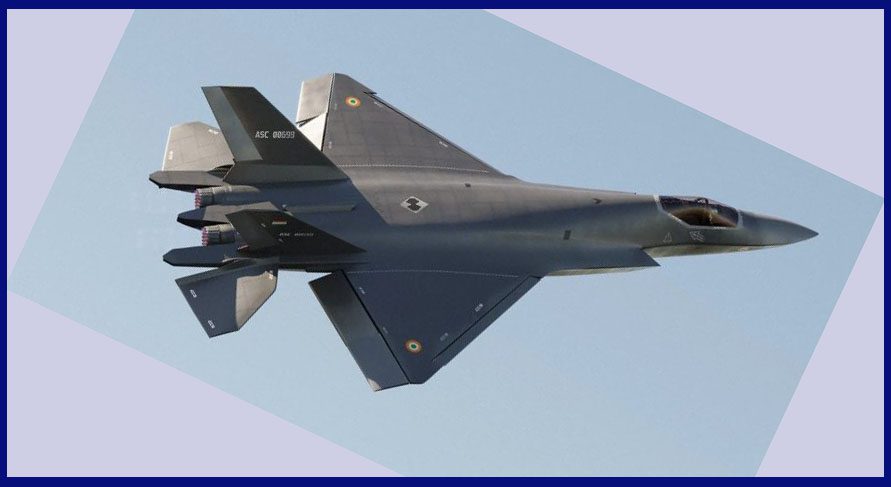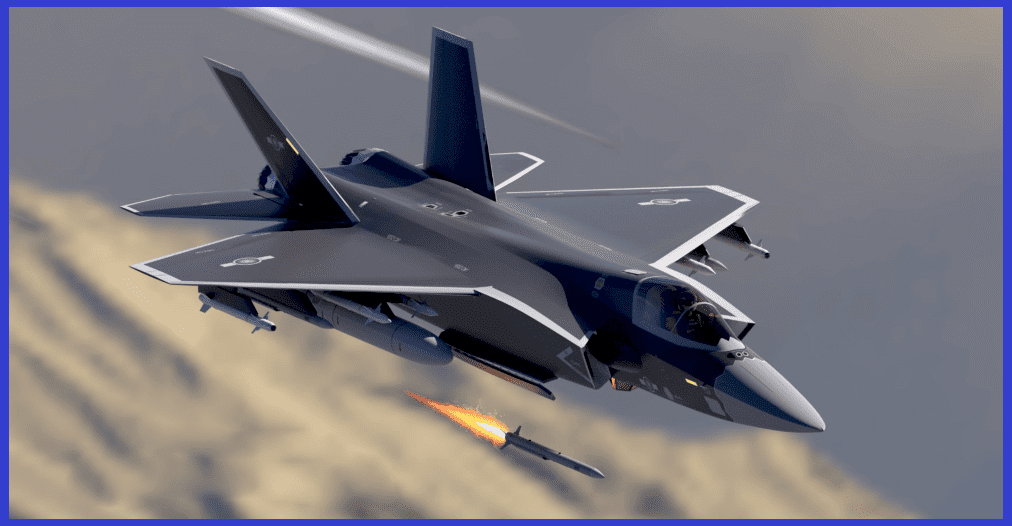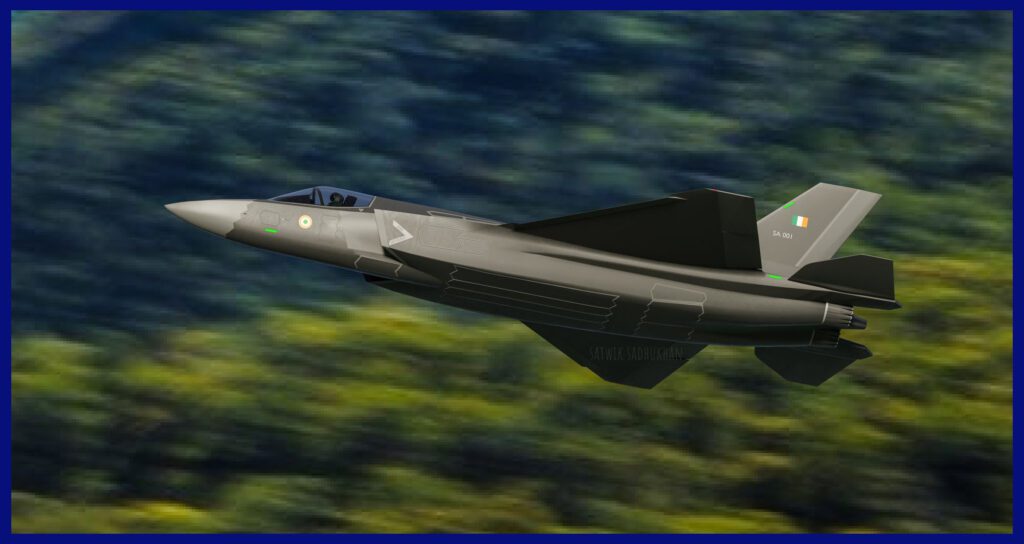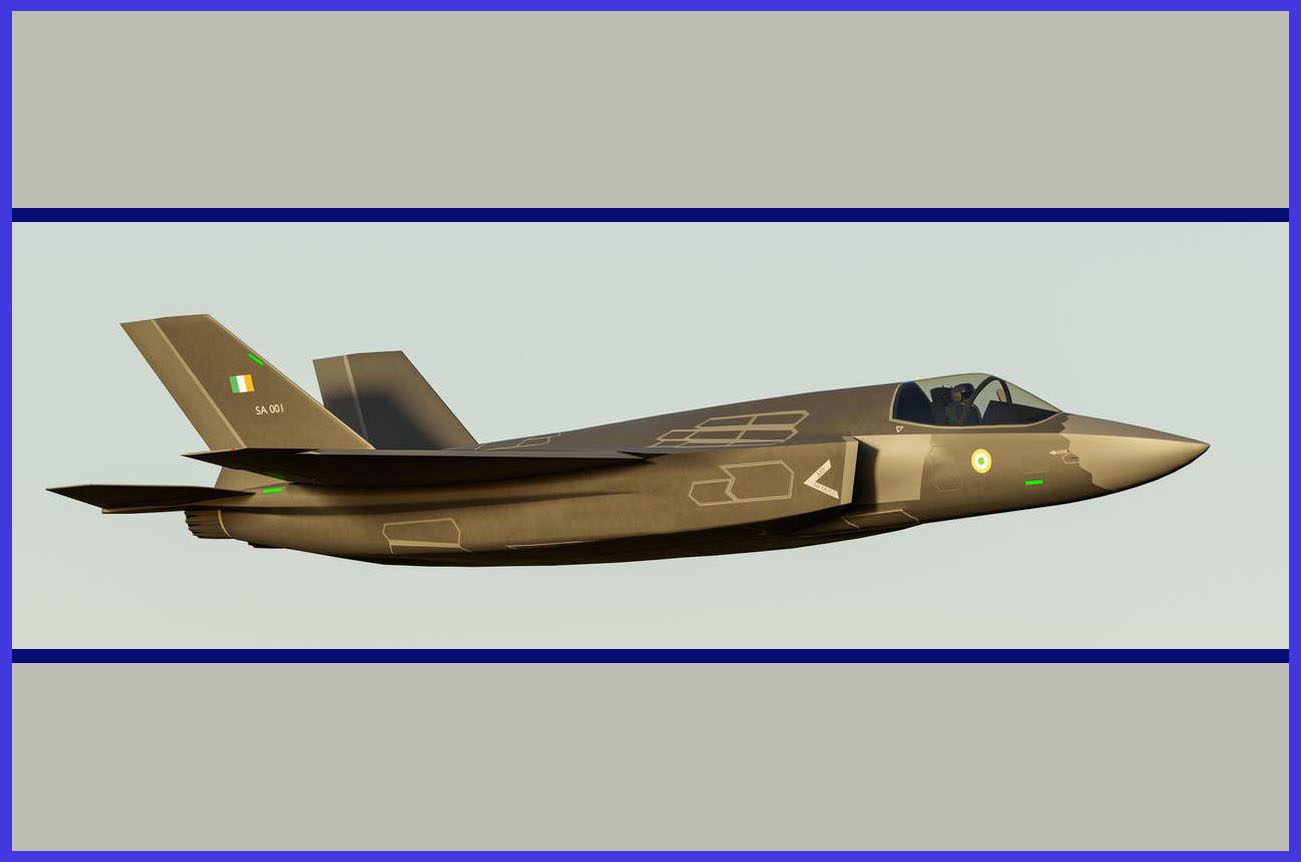The Finest Step Towards Self-Reliance!! Discover the Best of the 5th Gen Stealth AMCA Aircraft under development by India. Designed to operate in both air superiority and ground attack roles, the AMCA (Advanced Medium Combat Aircraft) boasts advanced stealth capabilities to minimize its radar signature, making it extremely difficult for enemy air defences to detect and track. Its sleek and aerodynamically efficient design, combined with radar-absorbing materials, enhances its low observability. The aircraft is expected to offer superior agility, situational awareness, and electronic warfare capabilities, positioning it at the forefront of modern aerial warfare technology and strengthening India’s national defence capabilities.
Under the purview of the Defence Research and Development Organisation (DRDO), the Aeronautical Development Agency (ADA) is entrusted with the responsibility of aircraft design. The DRDO, Hindustan Aeronautics Limited (HAL), and a private Indian corporation are expected to collaborate on its production as part of a public-private joint venture. The AMCA will be equipped with advanced radar systems, cutting-edge avionics, and a range of precision-guided weapons. It will possess the capability to deploy both air-to-air and air-to-ground munitions, rendering it a versatile asset for the Indian Air Force and the Indian Navy.

The aircraft in question is designed to be a single-seat, twin-engine configuration. The initial variant, referred to as the Mark 1, is set to incorporate 5.5 generation technologies, while the Mark 2 will introduce progressive 6th generation technology enhancements. The Advanced Medium Combat Aircraft (AMCA) is envisioned to undertake a diverse range of missions, encompassing air supremacy, ground-strike capabilities, the suppression of enemy air defences (SEAD), and electronic warfare (EW) missions. It is intended to serve as a formidable replacement for the Sukhoi Su-30MKI air superiority fighter, which currently constitutes the core of the Indian Air Force’s fighter fleet.
As reported by The Indian Express in early 2023, the Defense Research and Development Organization (DRDO) has successfully completed the design phase of the aircraft. The organization is presently awaiting a “Critical Design Review” to ensure the system’s readiness for further stages involving fabrication, demonstration, and testing, ensuring that it meets the requisite performance standards. The estimated development cost for the AMCA project stands at approximately ₹15,000 crore, which is equivalent to around $2 billion.

Development Program of the AMCA
Conceptualization: The program was strategically crafted to bridge the gap between the heavyweight Sukhoi Su-30MKI and India’s Light Combat Aircraft (LCA). Its primary goal is to equip the Indian Air Force with a cutting-edge, domestically developed, versatile stealth fighter. This endeavour by India to create a fifth-generation fighter is known as the AMCA, formerly referred to as the Medium Combat Aircraft (MCA) program. It initially stood as a competitor program before evolving into the Indo-Russian Sukhoi/HAL FGFA.
In the year 2010, the AMCA program was officially launched. It’s worth noting that the AMCA currently falls within the 25-ton class fighter category, although its original design aimed for a 20-ton class fighter. The journey commenced in October 2010 with a feasibility study, followed by the project definition and preliminary design stages in 2013.
Prototyping and Testing: The program encompasses the creation of prototype aircraft for comprehensive testing and validation. This phase entails rigorous flight testing and evaluation to refine the aircraft’s capabilities. Over the period from November 2013 to December 2014, an extensive review was carried out, considering nine different AMCA design configurations, denoted as 3B-01 through 3B-09. This comprehensive evaluation involved the utilization of computer-aided design (CAD), assessments in both low- and high-speed wind tunnels and radar cross-section (RCS) testing.
By the close of 2014, the configuration 3B-09 was selected. In 2015, the fundamental design configuration of the AMCA was solidified and received approval from the Indian Air Force (IAF) in 2016. It’s important to note that as of October 2022, the AMCA is still pending approval from the Cabinet Committee on Security (CSS), a crucial step in the development of the prototype. The prototype can be released in three years, and the maiden flight can happen one to one and a half years after that, according to Dr. A.K. Ghosh, project director of AMCA.

Design Analysis of the AMCA Program
Stealth Design: One of the primary design features of the AMCA is its emphasis on stealth technology. The aircraft’s design incorporates a sleek, low-observable shape, radar-absorbing materials, and minimized external protrusions to reduce its radar cross-section. This design element is essential for the AMCA’s survivability in modern aerial combat. Specifically, The internal weapons bay, twin-tail layout, platform edge alignment and serration, body conformal antenna and low intercept radar, diverter-less supersonic inlet (DSI) with serpentine ducts that conceal engine fan blades, and extensive use of composites in the airframe all contribute to the AMCA design’s inherent radar stealth.
Advanced Avionics & Sensors: The design of the aircraft incorporates cutting-edge avionics and sensor systems, endowing it with superior situational awareness and the capability to engage multiple targets simultaneously. This integration of advanced radar, electronic warfare systems, and data fusion capabilities significantly amplifies its combat effectiveness.
To enhance situational awareness and facilitate seamless collaboration with the advanced electronic warfare (EW) suite onboard the AMCA, the inclusion of distributed passive sensors equipped with AI-assisted multi-sensor data fusion is anticipated. The AMCA employs fast processors and intelligent subsystems within its distributed processing system. Furthermore, the aircraft is designed to incorporate an integrated sensor-fusion-based vehicle health monitoring system.
A stronger and more potent iteration of the Uttam AESA Radar, utilizing gallium nitride (GaN) technology, is slated for installation on the AMCA. This radar system will be complemented by a steerable mechanical mount. Additionally, there are intentions to implement an onboard condition monitoring system within the AMCA.

Internal Armament: The AMCA is equipped with an internal weapons compartment for the stealthy transport of missiles and standoff precision-guided munitions. It also has provisions for external hardpoints for the external transport of ordnance for non-stealthy missions. On the aircraft, directed energy weapons are also expected to be installed.
Futuristic Cockpit: The AMCA is designed to feature a glass cockpit equipped with a wide-angle holographic head-up display, a multi-function display (MFD), and an expansive panoramic touchscreen display, enhancing man-machine interaction. Furthermore, the AMCA incorporates a hands-on throttle-and-stick (HOTAS) arrangement, with the right hand managing the stick and the left hand controlling throttle settings to alleviate the pilot’s workload.
Collaborative Engine Development: A crucial element of the AMCA’s design revolves around the creation of indigenous engines. Though the specific engine selection may undergo adjustments, the primary objective remains the same: to develop potent, dependable, and fuel-efficient engines that align with the aircraft’s performance criteria. The AMCA is set to be propelled by two afterburning turbofan engines. The initial blueprint involves the installation of the General Electric F414 afterburning turbofan engine on AMCA Mark-1, while a more robust joint venture (JV) engine is in the works for AMCA Mark-2.
As per the Horizon 2047 document on India-France strategic cooperation, on July 15, 2023, India and France decided to work together on the joint development of a combat aircraft engine that would power the Mark-2 variant of AMCA. By late 2023, the Defence Research and Development Organisation (DRDO) of India and the French company Safran would have a project roadmap ready.

AMCA Salient Features Will Be:
- Diverter-less Supersonic Intake ( DSI ) with serpentine duct
- All moving horizontal tails and twin-canted vertical tails with Composite & Radar Absorbing Structures
- Internal Weapons Bay ( IWB ) with BVR missiles and precision-guided bombs. Inserted fuel tanks for extended range in lieu of weapons
- FSS radome & conformal apertures
- Internal Electronic Warfare Suite consisting of Radar Warning Receivers ( RWR ), Interferometer etc
- Extended detection range sensors ( like AESA radar & IRST )
- Smart Cockpit LAD ( large area display ), Smart sleek waveguide base HUD, advanced HMDS, 3D Audio Warnings and Pilot Voice Commands
- Network Centric Capability, multi-sensor data fusion and electronic pilot for autonomous missions
- Retractable Air-To-Air Refueling Probe
- Maintenance-friendly aircraft with ease of access and interchangeability
Estimated Specifications for the AMCA (as of 2023)
- Length: 57 ft 9 in ( 17.6 m )
- Wingspan: 36 ft 6 in ( 11.13 m )
- Height: 14 ft 9 in ( 4.5 m )
- Wing area: 590 sq ft ( 55 m2 )
- Maximum take-off weight: 25,000 kg ( 55,116 lb )
- Payload: 6,500 kg (14,300 lb) / 1,500 kg (3,300 lb) Internal and 5,000 kg ( 11,000 lb ) External stores
- Fuel capacity: 6,500 kg ( 14,300 lb )
- Power plant: 2 x GE F414 to be modified, each requiring 90 kN Thrust
- Combat range: 1,620 km ( 1,010 mi, 870 nmi )
- Service ceiling: 60,000 ft
- Speed: Mach 2+
- ‘g’ limits: Maximum 8g
- Hardpoints: The aircraft is planned to have a total of 14 hard points. When operating in stealth mode, it will be outfitted with 4 internal hardpoints, while an additional 10 external hard points will be incorporated for non-stealth missions. The aircraft’s versatility enables it to carry various combinations of cutting-edge Air-to-Air missiles, which include ASRAAM, Astra, Meteor, Python & Derby. Additionally, it will have the capacity to carry Air-to-Surface missiles like BrahMos NG, SANT, and Rudram, as well as precision-guided and laser-guided bombs such as Paveway, JDAM, Hammer and Spice.
In conjunction with this article, take advantage of a unique opportunity to obtain the superb large-scale 1/72 premium diecast model of a US Air Force Lockheed Martin F-22A Raptor. These iconic and highly acclaimed military aircraft have an outstanding history, and they are currently accessible for purchase through AirModels with worldwide delivery options. Don’t miss your chance to secure one of these models before our limited stock is sold out. Click here now to make your purchase.

In conclusion, the Advanced Medium Combat Aircraft (AMCA) program represents a significant milestone in India’s pursuit of advanced aerospace capabilities. The program’s meticulous design analysis has led to the creation of a versatile, stealthy, and technologically advanced fighter aircraft. By combining cutting-edge features such as stealth technology, multi-role versatility, advanced avionics, and indigenous engine development, the AMCA is poised to strengthen India’s national defence and elevate its position in the global aerospace arena.
The AMCA is not just an aircraft; it embodies India’s commitment to self-reliance, technological innovation, and strategic independence. Its successful development and deployment will contribute to the nation’s security, while also serving as a symbol of India’s growing prowess in the defence industry.
As the program progresses through prototyping, testing, and production, the AMCA is expected to play a pivotal role in the Indian Air Force, bolstering its capabilities for decades to come. The design analysis has laid a solid foundation for this ambitious project, underscoring the nation’s dedication to advancing aerospace technology and ensuring a robust defence posture.
Important Announcement for Our Valued Readers!
After an article is published, it is possible that updates or changes may have occurred beyond the time of publication. Therefore, it is important to be aware that certain information in the article might be outdated. To ensure the most accurate analysis, it is highly recommended to verify the content with the latest sources available.
However, we are dedicated to delivering outstanding articles on military products and global updates. Maintaining quality and smooth operation requires resources. Your support sustains our efforts in providing insightful content. By purchasing high-quality products through our affiliated links, you help us keep our platform alive and acquire top-notch items. Your unwavering support is invaluable and inspires us to strive further.
We welcome your suggestions and requests for more information, as we value feedback from our readers. If there’s specific defence material or equipment not covered on our site, please share your request in the comments. We’ll strive to research and provide the required information. We sincerely thank you for your unwavering interest in our website, and we eagerly anticipate hearing from you! Enjoy your reading experience!
